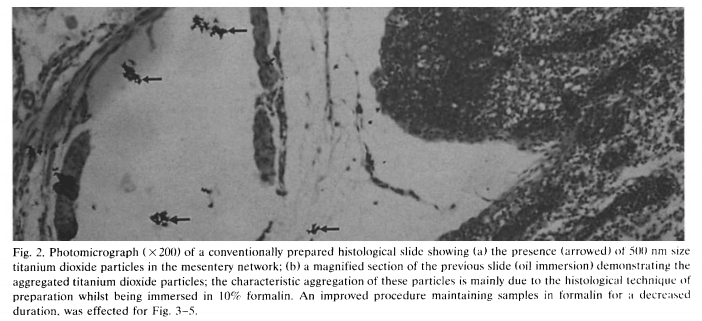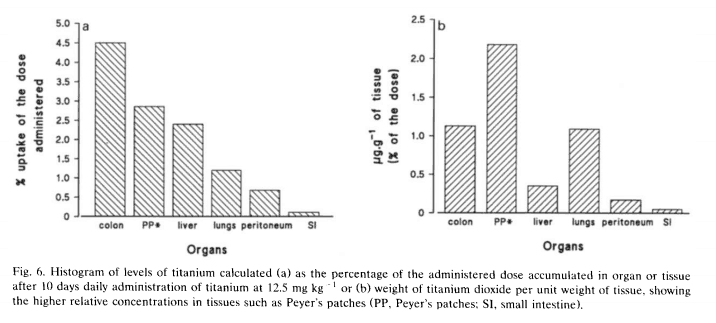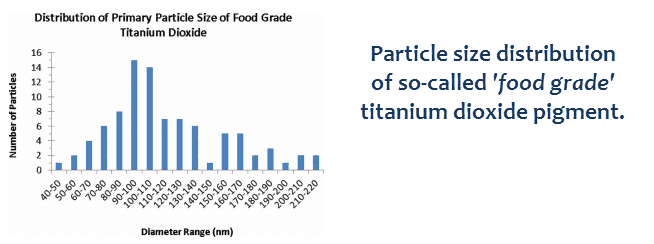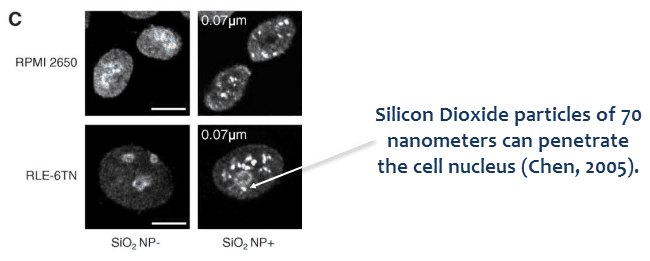
[cmamad id=”26186″ align=”center” tabid=”display-desktop” mobid=”display-desktop” stg=””]
And you probably consumed some already today without even knowing it…

—-Important Message From Our Sponsor—-
Make them jealous of your swing… Here’s how to beat younger golfers, no matter your skill level
A great golf swing isn’t about raw power… It’s about finesse, technique, wisdom, and patience…
And that’s something we get as we mature.
A bet against a spry 20-year-old? I’ll take that any day of the week.
But I’d think twice about playing a guy in his 70s…
Especially if he knows this simple (but very effective) senior swing technique.
I got Shawn on camera so I could share it with you.
Click here to check it out right now and start beating younger players into submission.
———-
Supposedly harmless chemical enters your brain and spinal fluid
Large-scale manufacturers of foods, supplements, and sunscreens prefer the idea that insoluble pigments cannot be absorbed and hence pose no risk.
They want to believe: If it’s not soluble, you can swallow it and it will just pass through your gut.
They are wrong.
Small particles are often called nanoparticles. Nano means very small.
BUT… The nanoparticles in your food, supplements and prescriptions are HARMFUL.
Because not only are nanoparticles freely absorbed after oral consumption, some of them have been shown to be mutagenic.
Painters were using the pigment titanium dioxide (TiO2 ) long before it found its way into our sunscreens, foods, and supplements.
Titanium dioxide is very white and it scatters light better than any known mineral.
It’s used in white paint.
Over time, this property of titanium dioxide of being VERY white has led to it being used by other industries.
Today, titanium dioxide is what makes powdered donuts and calcium pills look whiter than they really are.
Though long presumed harmless, science now shows that this artificial enhancement of aesthetics comes at a price.
Most consumers care more about their health than they do about minor nuances in product appearance.
So they should know about the dangers in order to better choose which brands to buy.
According to Praful Jani of the first study I’m going to talk about here:
“…uptake of inert particulate matter, such as titanium dioxide, used in pharmaceuticals and food poses the question whether insolubility and inertness necessarily guarantees their innocuous nature.”
Despite what product formulation chemists, Madison Avenue, and superfluous brand advisers seem to think, most people don’t actually care about the precise tint of their calcium pills.
Eggshell-white is good enough for most things.
Our bodies absorb titanium dioxide nanoparticles. They have been detected in various organs, including the brain.
A few years after their absorption and bodily distribution were demonstrated by toxicologists, a team of biochemists also discovered that they can bind strongly to DNA.
And, moreover, the same property lending the pigment its uncanny hue contributes to its toxicity.
Titanium dioxide absorbs light in the UV region.
But before this is reflected, electrons are excited – producing free radicals in solution.
“…the International Agency for Research on Cancer (IARC), therefore, has classified TiO2 as a Group 2B carcinogen (possibly carcinogenic to humans).”
The science is fairly clear that titanium dioxide should be on everybody’s “avoid” list.
Most people realize that additives can be dangerous…
But few realize just how dangerous insoluble nanoparticles really are – and especially titanium dioxide.
But that’s only because they haven’t read the studies:

In this study, they fed titanium dioxide particles of 500 nanometers (nm) in diameter to rats daily at 12.5 mg/kg for ten days.
After a brief washout period, they examined the organs to determine their titanium levels determined.
These 500 nm particles were freely absorbed and many were found translocated to the liver, lungs, and lymph nodes.

This is perhaps not too surprising when considering the classic studies of Volkheimer, who proved over 40 years ago that dry starch particles as large as 150 μm (micrometers) can be persorbed intact.
The particles used in this study were 300 times smaller than that.
Not surprisingly, more particles in total were found in intestinal tissue than anywhere else.
But they found the highest concentrations in the Peyer’s patches (lymphatic tissue in the small intestine).

As part of the immune system, this distribution implies that titanium dioxide nanoparticles are transported via macrophages – immune cells capable of engulfing particles and bacteria.
It was previously shown that injected aluminum oxide nanoparticles, such as those present after vaccination, can travel from the muscle to the brain.
“The use of insoluble materials as chemical additives in the pharmaceutical and food industries perhaps needs some re-evaluation.”
The authors of the study we’re talking about now didn’t bother to determine whether these particles were translocated to the brain in particular.
But a later study did check for this:

This study used slightly smaller 25-155 nm particles at a much higher dose, aiming to determine the lethal dose (LD50.)
They also analyzed more organs.
In addition to the liver and lungs, these researchers detected titanium dioxide particles in the kidneys and brain.
Again, this is not completely without precedent.
Previously, vaccine nanoparticles and dry starch granules had both been shown to do this as well.

The slightly larger fine particles (55 nm) were the most efficient in brain migration, while those of the 80 nm size appeared most in the liver.
Coincidentally, this is roughly the range of nanoparticle sizes found mostly in foods and supplements.

Although these toxicologists proved that large doses can be fatal, these studies were not designed to determine long-term effects at smaller doses.
“The mice had a slight brain lesion associated with exposure to TiO2 particles.”
Chronic consumption of titanium nanoparticles over the course of months to years is what is relevant here.
Millions of humans consume these particles every day in powdered donuts, pills, and candy.
But the biochemists in this study did what the toxicologists hadn’t done:

In a more human-relevant study, they gave mice titanium dioxide nanoparticles in their drinking water.
The low water solubility of TiO2 places constraints on how much can be delivered, effectively limiting the daily dose to small amounts.
Then they measured DNA damage in four ways:
- Determined the amount of hydroxylated DNA, or damage created by the free hydroxyl radical (ȮH)
- Measured for a phosphorylated histone called gamma-H2AX, a biomarker for DNA double strand breaks
- Determined DNA strand breaks directly
- Used genetically modified mice that would revert to an easily discernible wild-type gene upon DNA damage
And in every way they tested, these sub-chronic doses of titanium dioxide caused dose-dependent DNA damage.
[cmamad id=”26187″ align=”center” tabid=”display-desktop” mobid=”display-desktop” stg=””]
Titanium dioxide nanoparticles also increased interferon-gamma levels (INFγ), proving that the immune system is involved.
“About 70% of particles have a size of 160 nm.”
This could cause damage in itself…
Cytokines such as INFγ, tumor necrosis factor alpha (TNFα), and interleukin 1 beta (IL-1β) induce nitric oxide, superoxide, and hypochlorite production to destroy invading bacteria.
We do need those small reactive molecules to protect against bacteria and parasites.
But directing these against titanium dioxide nanoparticles does nothing to fix the problem.
An immune response to titanium is pointless, and only serves to exacerbate the damage.
The DNA damage observed may initially seem surprising…
But once we realize that titanium dioxide is a photocatalyst that’s also been shown to bind DNA, such results are to be expected.

Titanium oxide also promotes free radical production, especially when excited by light.
It’s often assumed this wouldn’t occur in the body because the body interior is “dark” – but biophotons are in fact present in living tissue.
This “ultra-weak bioluminescence” is commonly explained by the emission of super- oxide, a fluorescent molecule.
But there is reason to think that heme is involved.
Regardless of how it happens, titanium dioxide has been shown to bind DNA even in darkness:

They took this precaution because titanium dioxide is a well-known photocatalyst.
Previously, it had been shown to be capable of absorbing UV energy and causing DNA strand breaks.
Another study, about chemical oxidation and DNA damage catalyzed by inorganic sunscreen ingredients, was conducted in the dark.
“…however, TiO2 absorbs about 70% of incident UV, and in aqueous environments this leads to the generation of hydroxyl radicals which can initiate oxidations.”
This study demonstrated the interaction between TiO2 and DNA in a variety of ways.
They showed the DNA binding via IR spectroscopy, gel shift assay, and even visualized it with electron microscopy:

They used 10 nm particles on average, but particles up to 70 nm have been shown to penetrate the cell nucleus.
And, often times, the larger particles are simply an agglomeration of many smaller ones.
To summarize, studies have cumulatively shown that ingested titanium dioxide nanoparticles can:
- Penetrate the cell membrane (≤5000 nm)
- Penetrate the cell nucleus (≤70 nm)
- Bind DNA (~10 nm)
- Cause DNA damage (25-155 nm)
That pretty much forces us to reconsider buying the products that contain them.
Some brands of aspirin are entirely free of titanium dioxide nanoparticles… But most brands do contain it.
Humans have probably been ingesting trace levels of silicon dioxide nanoparticles for millennia…
But now we are exposed to much higher doses of a different mineral.
And since many Americans do end up with cancer somehow, I think it’s good to err on the side of caution and avoid titanium dioxide.
—-Important Message—-
My story: Erections that cured my anxiety
I suffered for years… I used to wake up in a cold sweat.
4 in the morning. Have you ever had 4 in the morning thoughts?
These thoughts go round and round in your head. What if… What happens when…
Will she leave me?
Is my daughter really safe?
Am I in danger of being fired?
These thoughts get your pulse high and make you feel weak and stressed out…
Your sleep suffers and you feel anxious when you should feel confident.
Weirdly enough, I discovered a simple way to get great erections, get my confidence back, AND lose all my stress and anxiety.
Erections like these actually lower stress hormones to almost zero.
It’s incredible. These erections kill stress and anxiety and make you feel pumped up, full of confidence, and relaxed.
Who knew that any kind of erection could eliminate anxiety and make life go so smoothly?

———-

- Jani, Praful. "Titanium dioxide (rutile) particle uptake from the rat GI tract and translocation to systemic organs after oral administration." International journal of pharmaceutics (1994) https://www.sciencedirect.com/science/article/pii/0378517394904618
- Wang, Jiangxue. "Acute toxicity and biodistribution of different sized titanium dioxide particles in mice after oral administration." Toxicology letters (2007) https://s3.amazonaws.com/academia.edu.documents/44021406/Acute_toxicity_and_biodistribution_of_di20160323-1685-mmn4ul.pdf?AWSAccessKeyId=AKIAIWOWYYGZ2Y53UL3A&Expires=1529707940&Signature=U7ZvWMItinWX7OeP06El39xQhak%3D&response-content-disposition=inline%3B%20filename%3DAcute_toxicity_and_biodistribution_of_di.pdf
- Trouiller, Benedicte. "Titanium dioxide nanoparticles induce DNA damage and genetic instability in vivo in mice." Cancer research (2009) http://cancerres.aacrjournals.org.sci-hub.nu/content/69/22/8784.short
- Dunford, Rosemary. "Chemical oxidation and DNA damage catalysed by inorganic sunscreen ingredients." Federation of European Biochemical Societies letters (1997) https://www.sciencedirect.com/science/article/pii/S0014579397013562
- Zhu, R. "A novel toxicological evaluation of TiO2 nanoparticles on DNA structure." Chinese Journal of Chemistry (2007) http://onlinelibrary.wiley.com/doi/10.1002/cjoc.200790186/full
- Titanium dioxide in our everyday life; is it safe? https://www.ncbi.nlm.nih.gov/pmc/articles/PMC3423755/
- Titanium Dioxide https://www.chemicalsafetyfacts.org/titanium-dioxide/
